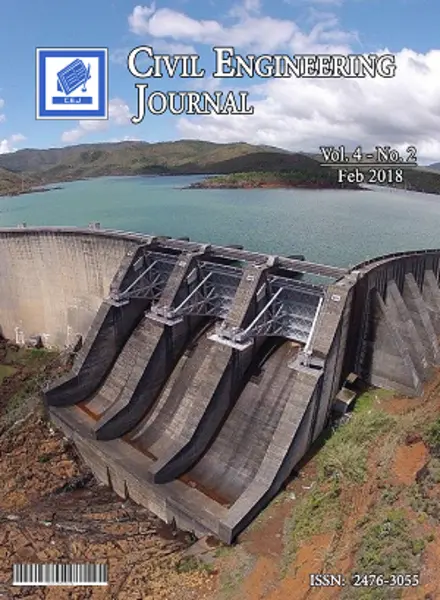-
integrating system dynamics and remote sensing to estimate future water usage and average surface runoff in lagos, nigeria
جزئیات بیشتر مقاله- تاریخ ارائه: 1400/08/01
- تاریخ انتشار در تی پی بین: 1400/08/01
- تعداد بازدید: 522
- تعداد پرسش و پاسخ ها: 0
- شماره تماس ژورنال: 982188779475ext.258
the goal of this study was twofold; first analyze the patterns of water consumption in lagos, nigeria and use them in a system dynamics (sd) model to make projections about future demand. the second part used remote sensing to quantify the contribution of extensive land use/cover change to urban flooding. land use/cover dynamics over the past decade was analyzed using satellite imagery provided by landsat thematic mapping (tm). unsupervised classification was performed with false color composite using the iterative self-organizing data analysis (isodata) technique in a geographic information systems (gis). the study area was divided into four different land use types during image classification: bare land, built-up area, water bodies, and vegetation. for water demand, two different scenarios of population growth including 5.5% and 2.75 % annual increase were considered. the results showed that water demand dropped by 67% of its current value when losses in distribution were reduced by 20% and population annual growth rate kept at 2.75% over the study period. bare land and water bodies lost 1.31% and 1.61% of their current area respectively while built-up area grew by 1.11%. these changes in land use/cover changes led to a 64% increase in average surface runoff, mostly attributable to increasing surface imperviousness and the absence of an adequate urban drainage system.
حوزه های تحت پوشش ژورنال
مقالات جدیدترین رویدادها
-
استفاده از تحلیل اهمیت-عملکرد در ارائه الگوی مدیریت خلاقیت سازمانی و ارائه راهکار جهت بهبود
-
بررسی تاثیر ارزش وجوه نقد مازاد بر ساختار سرمایه شرکت های پذیرفته شده در بورس اوراق بهادار تهران
-
بررسی تأثیر سطح افشای ریسک بر قرارداد بدهی شرکت های پذیرفته شده در بورس اوراق بهادار تهران
-
بررسی تأثیر رتبه بندی اعتباری مبتنی بر مدل امتیاز بازار نوظهور بر نقد شوندگی سهام با تأکید بر خصوصی سازی شرکت ها
-
تأثیر آمیخته بازاریابی پوشاک ایرانی بر تصویر ذهنی مشتری پوشاک ایرانی (هاکوپیان)
-
بررسی تغییرات الکتروکوکلئوگرافی و پاسخهای شنیداری ساقه مغز در 100 بیمار مبتلا به منیر در بیمارستان رسول اکرم (ص) 1379-1377
-
تأثیر هوش هیجانی، ویژگی های شخصیتی و روابط بر تمایل به تغییر رفتار مصرف کننده در صنعت ورزش
-
واکاوی وضعیت آموزش مهارت های اساسی زندگی در پایه ششم ابتدایی از دیدگاه معلمان و متخصصان
-
بازشناسی راهکارهای طراحی مطابق با الگوهای پایداری محیطی در معماری بافت قدیم بوشهر
-
بررسی آزمایشگاهی رفتار شمع پافیلی تحت بارهای کششی مایل در خاک ماسه ای
مقالات جدیدترین ژورنال ها
-
مدیریت و بررسی افسردگی دانش آموزان دختر مقطع متوسطه دوم در دروان کرونا در شهرستان دزفول
-
مدیریت و بررسی خرد سیاسی در اندیشه ی فردوسی در ادب ایران
-
واکاوی و مدیریت توصیفی قلمدان(جاکلیدی)ضریح در موزه آستان قدس رضوی
-
بررسی تاثیر خلاقیت، دانش و انگیزه کارکنان بر پیشنهادات نوآورانه کارکنان ( مورد مطالعه: هتل های 3 و 4 ستاره استان کرمان)
-
بررسی تاثیر کیفیت سیستم های اطلاعاتی بر تصمیم گیری موفق در شرکتهای تولیدی استان اصفهان (مورد مطالعه: مدیران شرکتهای تولیدی استان اصفهان)
-
پیش بینی انسجام و کارکردهای خانوادگی در زوج ها، براساس عمل به باورهای دین
-
جرم شناسی اطفال و ارزیابی شخصیت اطفال بزهکار
-
تجلی مضامین دینی در نقوش انسانی ظروف سفالین دوره سلجوقی
-
determination of organochlorine and organophosphorous pesticide residues in irrigated water from gubi, waya dams and gudum fulani irrigation sites in bauchi lga, bauchi state,nigeria using composite sampling
-
investigation into the effect of bed stiffness on seismic performance of concrete gravity dam under far- and near- field earthquakes


سوال خود را در مورد این مقاله مطرح نمایید :